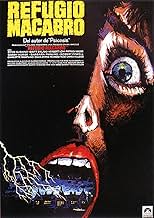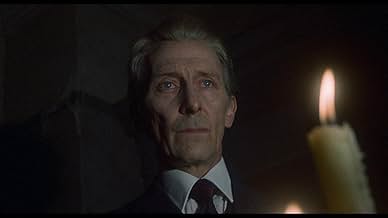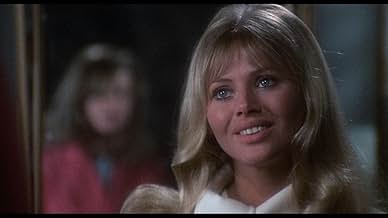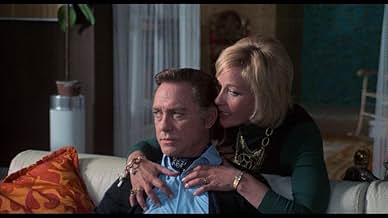IMDb रेटिंग
6.5/10
8.8 हज़ार
आपकी रेटिंग
अपनी भाषा में प्लॉट जोड़ेंIn order to secure a job at a mental institution, a young psychiatrist must interview four patients inside the asylum.In order to secure a job at a mental institution, a young psychiatrist must interview four patients inside the asylum.In order to secure a job at a mental institution, a young psychiatrist must interview four patients inside the asylum.
- पुरस्कार
- कुल 2 जीत
Frank Forsyth
- Asylum Gatekeeper (segment "Mannikins of Horror")
- (बिना क्रेडिट के)
Daniel Johns
- Otto the Dummy (segment "The Weird Tailor")
- (बिना क्रेडिट के)
Sylvia Marriott
- Asylum Head Nurse (segment "Mannikins of Horror")
- (बिना क्रेडिट के)
फ़ीचर्ड समीक्षाएं
Linking story: this was one I had for some reason missed out on a number of times on TV, and I'm certainly glad I've watched it now in this definitive DVD edition; it has perhaps the best linking narrative of the three Amicus anthologies in the set, with Moussorgsky's "Night On Bald Mountain" music (to say nothing of a remarkable sequence of shots where the protagonist, and us with him, is mesmerized by a number of disturbing illustrations that are lined up on the walls along the asylum staircase) effectively setting the scene for its rather weird psychological concept that someone can 'hide' in the person of another (actually recalling the original story that THE THING FROM ANOTHER WORLD [1951] was based on, though I wonder how intentional this was...then again, John Carpenter's 1982 version was still ten years away, so perhaps Robert Bloch thought that an idea discarded by Howard Hawks was certainly good enough for him!); anyway, the cast is pretty strong even for a mere 'device' such as this sequence appears to be (alas, the one with John Bryans and John Bennett for THE HOUSE THAT DRIPPED BLOOD [1970] doesn't quite cut it in comparison though, as in that film, the fourth story here is effectively integrated with the scene-setting narrative), led by a fresh-faced but credible Robert Powell, a surprisingly subdued Patrick Magee and the characteristically Machiavellian figure of Geoffrey Bayldon.
"Frozen Fear": while no one individual episode particularly stands out from the rest, all are played for what they're worth by a succession of fine performers starting with Barbara Parkins, Richard Todd and Sylvia Syms in the first story; the central idea of dismembered limbs taking a life of their own is preposterous really (though I guess it can be explained by the mystical amulet worn by the Sylvia Syms character) but quite cleverly done actually (and it's certainly not a first - or last - for Amicus themselves); it does, however, give a distinctly surrealistic flavor to the scene that kind of offsets its inherent grimness and sensationalism.
"The Weird Tailor": the second story is also the longest and, in a way, most effective one; Barry Morse dominates this segment as the pitiful tailor asked by the mysterious and typically fussy Peter Cushing (who gets a memorable entrance here) to make him a suit from a rare and very special fabric; the center-piece takes place in Cushing's mausoleum-like mansion, where the grief he shows over his dead son is all too real for the actor himself - having lost his beloved wife of many years only a few months before (in fact, I'm surprised Cushing accepted such a role); the final twist is quite effective, and also looks forward to the fourth episode in the film.
"Lucy Comes To Stay": there is some consternation regarding this segment because it is said to slow down the film (allegedly it was originally intended as the opening story but producer Milton Subotsky changed the order of the scenes in Robert Bloch's script around) but I really didn't feel that it affected the overall pace of the film in any major way; if anything, it's the most 'realistic' of the four episodes (preceding the last, and perhaps most fanciful, tale) with fine performances by all concerned but especially, of course, Charlotte Rampling and Britt Ekland - whose relationship to one another (misleadingly hinting at lesbianism throughout) is a bit too close for comfort; the final revelation is not particularly startling in this case, but subtly handled nonetheless.
"Mannikins Of Horror": its 'soul transference' concept tying up to a degree with the main idea of the film, this bizarre installment is taken as far as it can go without crossing the boundary into the ridiculous; the robots on display here are clumsy, unattractive machines but their 'supernatural' connotations (echoes also of the superb "Sweets To The Sweet" story from THE HOUSE THAT DRIPPED BLOOD) certainly make for an effectively nasty climax, and Herbert Lom is persuasive in his small but incredible role; as in THE BEAST MUST DIE (1974), by the end we have to guess the true identity of one of the characters we got to meet during the course of the film - this one is not too difficult perhaps, but the sudden burst of violence that it produces (not to mention an ironic conclusion) gives the whole an unsettling power that is hard to shake off!
Now to the disc itself and the accompanying extras: like the other entries in this Collection, we get a very good transfer indeed under the circumstances. The Audio Commentary is a well-balanced talk with director Roy Ward Baker producing the factoids, while cameraman Neil Binney handles the more technical aspects of the production; Jonathan Sothcott efficiently moderates the discussion. The featurette "Inside The Fear Factory" is a fun little documentary that takes a peek into the Amicus filmography; unfortunately, it is rather short for its purpose and the footage it presents is restricted to the films on offer in this Box Set (which seems to indicate, regrettably, that Anchor Bay UK do not currently have a follow-up set in the pipeline!). Film notes, bios and a poster/stills gallery are typical of the stuff that comes with each disc in the Collection.
"Frozen Fear": while no one individual episode particularly stands out from the rest, all are played for what they're worth by a succession of fine performers starting with Barbara Parkins, Richard Todd and Sylvia Syms in the first story; the central idea of dismembered limbs taking a life of their own is preposterous really (though I guess it can be explained by the mystical amulet worn by the Sylvia Syms character) but quite cleverly done actually (and it's certainly not a first - or last - for Amicus themselves); it does, however, give a distinctly surrealistic flavor to the scene that kind of offsets its inherent grimness and sensationalism.
"The Weird Tailor": the second story is also the longest and, in a way, most effective one; Barry Morse dominates this segment as the pitiful tailor asked by the mysterious and typically fussy Peter Cushing (who gets a memorable entrance here) to make him a suit from a rare and very special fabric; the center-piece takes place in Cushing's mausoleum-like mansion, where the grief he shows over his dead son is all too real for the actor himself - having lost his beloved wife of many years only a few months before (in fact, I'm surprised Cushing accepted such a role); the final twist is quite effective, and also looks forward to the fourth episode in the film.
"Lucy Comes To Stay": there is some consternation regarding this segment because it is said to slow down the film (allegedly it was originally intended as the opening story but producer Milton Subotsky changed the order of the scenes in Robert Bloch's script around) but I really didn't feel that it affected the overall pace of the film in any major way; if anything, it's the most 'realistic' of the four episodes (preceding the last, and perhaps most fanciful, tale) with fine performances by all concerned but especially, of course, Charlotte Rampling and Britt Ekland - whose relationship to one another (misleadingly hinting at lesbianism throughout) is a bit too close for comfort; the final revelation is not particularly startling in this case, but subtly handled nonetheless.
"Mannikins Of Horror": its 'soul transference' concept tying up to a degree with the main idea of the film, this bizarre installment is taken as far as it can go without crossing the boundary into the ridiculous; the robots on display here are clumsy, unattractive machines but their 'supernatural' connotations (echoes also of the superb "Sweets To The Sweet" story from THE HOUSE THAT DRIPPED BLOOD) certainly make for an effectively nasty climax, and Herbert Lom is persuasive in his small but incredible role; as in THE BEAST MUST DIE (1974), by the end we have to guess the true identity of one of the characters we got to meet during the course of the film - this one is not too difficult perhaps, but the sudden burst of violence that it produces (not to mention an ironic conclusion) gives the whole an unsettling power that is hard to shake off!
Now to the disc itself and the accompanying extras: like the other entries in this Collection, we get a very good transfer indeed under the circumstances. The Audio Commentary is a well-balanced talk with director Roy Ward Baker producing the factoids, while cameraman Neil Binney handles the more technical aspects of the production; Jonathan Sothcott efficiently moderates the discussion. The featurette "Inside The Fear Factory" is a fun little documentary that takes a peek into the Amicus filmography; unfortunately, it is rather short for its purpose and the footage it presents is restricted to the films on offer in this Box Set (which seems to indicate, regrettably, that Anchor Bay UK do not currently have a follow-up set in the pipeline!). Film notes, bios and a poster/stills gallery are typical of the stuff that comes with each disc in the Collection.
Thrilling and creepy Onnibus movie formed by four seemingly unrelated tales of craziness dealing with a doctor : Robert Powell searching for a job. This doctor visiting the asylum tells each flick. Concerning the chilling and strange stories the following ones : A killer's victim, Sylvia Sims, seeks retribution . A taylor : Barry Morse pursued by a creditor seems to be collecting his bills. A woman plagued by a doppleganger . Finally, an amazing climax with a man : Herbert Lom, who makes dolls.
Creepy and eerie horror movie with magnificent color work and lighting efffects , as well as suitably sombre acting from an exceptional casting . Dealing with four stories of madness that are perfectly interwoven, being written by notorious Robert Bloch of Psycho and finely interpreted by a top-drawer cast . These stories deal with grisly killings in which body scraps having own life, a young girl plagued by a double, leading to a nail-biting spotlight with a man who makes voodoo toys, only to become one after that. A grotesque and terrifying movie, not as humorless as American terror pictures. This is one of several compilations produced by Amicus : Max Rosenberg , Milton Subotsky that abounded in the Engllish cinema of the 60s and 70s . The cast is frankly magnificent , delivering usual grim-faced support with a large plethora of prestigious and mainly British actors, such as : Richard Todd as a punished murderer , Patrick Magee giving a prominent role , Herbert Lom as a maker of living dolls , Sylvia Sims , Charlotte Rampling , Britt Ekland, Barbara Parkins, James Villiers and the great Peter Cushing in fine form as well .
This first-rate horror anthology with nice photography by Denis Coop was compellingly directed by Roy Ward Baker, creating competent atmosphere in evoking the horror . Baker provides a solid framework more chillingly effective than in any other Anthology films . He was a craftsman and expert on terror movies, such as : "And now the Screaming starts" , "The Monster Club", "Dr Jekill and Mrs Hyde" , "Scars of Dracula" , "Seven Brothers meet Dracula" , "Vampire Lovers" , "Vault of Horror", among others. Rating : Better than average.
Creepy and eerie horror movie with magnificent color work and lighting efffects , as well as suitably sombre acting from an exceptional casting . Dealing with four stories of madness that are perfectly interwoven, being written by notorious Robert Bloch of Psycho and finely interpreted by a top-drawer cast . These stories deal with grisly killings in which body scraps having own life, a young girl plagued by a double, leading to a nail-biting spotlight with a man who makes voodoo toys, only to become one after that. A grotesque and terrifying movie, not as humorless as American terror pictures. This is one of several compilations produced by Amicus : Max Rosenberg , Milton Subotsky that abounded in the Engllish cinema of the 60s and 70s . The cast is frankly magnificent , delivering usual grim-faced support with a large plethora of prestigious and mainly British actors, such as : Richard Todd as a punished murderer , Patrick Magee giving a prominent role , Herbert Lom as a maker of living dolls , Sylvia Sims , Charlotte Rampling , Britt Ekland, Barbara Parkins, James Villiers and the great Peter Cushing in fine form as well .
This first-rate horror anthology with nice photography by Denis Coop was compellingly directed by Roy Ward Baker, creating competent atmosphere in evoking the horror . Baker provides a solid framework more chillingly effective than in any other Anthology films . He was a craftsman and expert on terror movies, such as : "And now the Screaming starts" , "The Monster Club", "Dr Jekill and Mrs Hyde" , "Scars of Dracula" , "Seven Brothers meet Dracula" , "Vampire Lovers" , "Vault of Horror", among others. Rating : Better than average.
Very good photography, acting, dialog set this horror anthology above most others. There is a clever beginning which then evolves into 4 separate stories of individuals inside an asylum. The 1st story is the most gruesome. The 2nd story is the most intriguing and also has Peter Cushing in it doing a excellent job as usual. The 3rd story is the weakest and the 4 th story ties into the twist ending. With each story only lasting an average of 15 minutes, they keep the viewers interest. This also has a nice soundtrack { something almost totally missing from todays horror crap,remkaes and sequels} . For those of us who like style, originality and solid acting in our horror films, this deserves a look.
'Asylum' holds a special place in my heart as watching it on TV as a kid in the 70s is one of my earliest horror memories, along with Rod Serling's almost forgotten series 'Night Gallery' and the underrated Cushing/Lee movie 'The Creeping Flesh'. I watched 'Asylum' the other day for the first time in oh, twenty years at least, and while it wasn't anywhere near as scary as I remember it to be, it's still one of the better horror anthologies of the period. It's helped considerably by having Robert Bloch adapt his own stories, Roy Ward Baker ('The Vampire Lovers', 'Dr Jekyll and Sister Hyde') as the director, and it features a first rate cast including horror legends Peter Cushing, Patrick Magee, and Herbert Lom. The most effective stories for me were the two in the middle - the one with Barry Morse as a tailor with a mysterious client (Cushing), and the other with a fragile Charlotte Rampling being led astray by the sexy Britt Ekland. 'Asylum' has a few flaws sure, but it's still a very entertaining film, and horror buffs will enjoy it.
From the mid-1960s through the mid-1970s the British-based film studio Amicus was a rival to the more famous and productive Hammer Films. Amicus didn't go in for Gothics, as a rule, but they mastered the art of the so-called "portmanteau" film, where four or five short stories are presented within a linking framework. They also mastered the art of hiring noted(and often very fine) British actors for only a day or two's worth of shooting, so that the final product ends up with an all-star cast. "Asylum" followed 1965's "Dr. Terror's House of Horrors," which was immensely fun, if incredibly cheap; 1967's "Torture Garden," 1970's "The House that Dripped Blood," and 1972's "Tales From the Crypt," and one can argue that it is the best of the lot ("The Vault of Horror" and "From Beyond the Grave" followed in 1973, and the mini-genre wrapped up in 1980 with "The Monster Club," but all of those were somewhat inferior to the earlier films). The success of "Asylum" is not simply due to it's terrific cast -- Peter Cushing (who appeared in nearly all of Amicus's portmanteau films), Herbert Lom, Patrick Magee, Richard Todd, Britt Ekland, Barbara Parkins, Charlotte Rampling, Sylvia Sims, Robert Powell, Barry Morse and the undersung Geoffrey Bayldon -- or its intriguing stories by American author Robert Bloch (who also scripted "Torture Garden" and "House that Dripped Blood"), but also the down-to-earth direction by Roy Ward Baker. Baker manages to keep his, Bloch's, and his actors' tongues all out of their cheeks, and the film is all the better for it.
The framing story concerns a new doctor (Powell) interviewing at a remote asylum, and being challenged by the doctor in charge (Magee, a brilliant Shakespearean actor who all too often ended up doing inferior horror films) to identify the former director of the place, who is now an inmate. As Powell interviews the various inmates, the different stories ensue. For horror film fans, the best story is the first one (which was not the first one in the script, but was elevated to that position over Bloch's objections); while not giving the plot away, suffice to say that it takes a story device that could have been rendered very cheesily and makes it wonderfully effective and creepy. Amicus buffs, meanwhile, will recognize the linking story as probably the most effective and logical of any in the portmanteau series of films. The remaining stories are all fine, with the most outré being the one that Cushing stars in.
"Asylum" is definitely worth, uh, checking into.
The framing story concerns a new doctor (Powell) interviewing at a remote asylum, and being challenged by the doctor in charge (Magee, a brilliant Shakespearean actor who all too often ended up doing inferior horror films) to identify the former director of the place, who is now an inmate. As Powell interviews the various inmates, the different stories ensue. For horror film fans, the best story is the first one (which was not the first one in the script, but was elevated to that position over Bloch's objections); while not giving the plot away, suffice to say that it takes a story device that could have been rendered very cheesily and makes it wonderfully effective and creepy. Amicus buffs, meanwhile, will recognize the linking story as probably the most effective and logical of any in the portmanteau series of films. The remaining stories are all fine, with the most outré being the one that Cushing stars in.
"Asylum" is definitely worth, uh, checking into.
क्या आपको पता है
- ट्रिवियाShot in 24 days.
- गूफ़(at around 27 mins) When Bonnie is being chased by a severed arm crawling along the floor, a crew member's hand is visible, holding the arm to make it appear as if it is moving.
- भाव
[explaining why he's in a wheelchair]
Dr. Rutherford: Never turn your back on a patient.
- कनेक्शनFeatured in Stephen King's World of Horror (1986)
टॉप पसंद
रेटिंग देने के लिए साइन-इन करें और वैयक्तिकृत सुझावों के लिए वॉचलिस्ट करें
- How long is Asylum?Alexa द्वारा संचालित
विवरण
- रिलीज़ की तारीख़
- कंट्री ऑफ़ ओरिजिन
- भाषा
- इस रूप में भी जाना जाता है
- El asilo del terror
- फ़िल्माने की जगहें
- उत्पादन कंपनियां
- IMDbPro पर और कंपनी क्रेडिट देखें
- चलने की अवधि
- 1 घं 28 मि(88 min)
- रंग
- पक्ष अनुपात
- 1.85 : 1
इस पेज में योगदान दें
किसी बदलाव का सुझाव दें या अनुपलब्ध कॉन्टेंट जोड़ें

![Trailer [OV] देखें](https://m.media-amazon.com/images/M/MV5BNDg5MjU2ZmItOGYxYy00NWRkLTk5MTAtY2E1MjFmZDY1MzQyXkEyXkFqcGdeQXRyYW5zY29kZS13b3JrZmxvdw@@._V1_QL75_UX500_CR0)



































